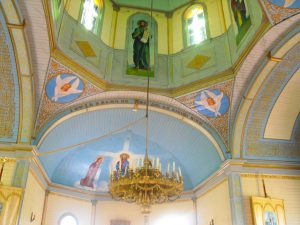Online Content
Ukrainian Christmas: A little history for the curious
January, 2017
Many Albertans have heard about Ukrainian Christmas and know it falls in January, not December. For those who don’t celebrate this holiday you may find this later date strange, so here is a bit of background as to why Ukrainian Christmas is celebrated 13 days after December 25th.

The main reason has to do with calendars. While most of the world follows the Gregorian calendar (a.k.a. New Style), which places Christmas on December 25th, most Orthodox churches such as the Russian, Serbian and Ukrainian churches still follow the Julian calendar (a.k.a. Old Style), which places Christmas on January 7th. The Julian calendar is pretty close to the true solar year we all know, but every 128 years it gains a whole day. Since its inception in 45 BCE, there are at least 10 days extra. The Gregorian calendar, implemented by Pope Gregory XIII in 1528 CE, solved this by using leap years. In the year 2101, Ukrainian Christmas will be on January 8th.
On January 5th, those of the Ukrainian Orthodox faith celebrate Svyata Vecherya—or Sviata Vechera to North Americans—which means “Holy Supper.” This is Christmas Eve, and it’s a time for the family to spend together. The children keep a watchful eye in the Eastern evening sky for the first star that symbolizes the trek of the Three Wise Men to Bethlehem. When the children see it, the feast begins. The supper table in farming homes is covered with wheat to symbolize the manger, which is then covered with a special tablecloth. The centrepiece is a candle encircled by three braided loaves called kollach or kalach. The three loaves symbolize the Trinity, and the circle symbolizes Eternity, though some say the three loaves also symbolize prosperity. The head of the household then brings in a didukh, which means “grandfather spirit.” The didukh is a sheaf of wheat that symbolizes the family’s ancestors. If the family is in a town centre, a few stalks of wheat are put in a vase to decorate the table. And if a family member has recently died, an empty chair is set at the table for remembrance. Prayers and traditional Christmas greetings are offered, and the family begins to eat.
Up until this point, a fasting has been observed to commemorate Mary’s difficult journey to Bethlehem. Twelve meatless dishes are served to represent the twelve apostles. All those at the table are expected to have something of each dish. The first and most important dish is called kutya. This dish is made out of cooked wheat, honey, ground poppy seeds and sometimes chopped nuts. Some families have a tradition of throwing a spoon of kutya up at the ceiling; if it sticks, it means there’ll be a prosperous harvest in the new year. After supper, carols are sung and at midnight or dawn the family attends a special church service.
Also, there is the celebration of the Feast of Epiphany, which occurs 12 days after Christmas—January 6th on the Gregorian and January 19th on the Julian. The Epiphany celebrates the Wise Men who travelled to visit Jesus, as well as when Jesus was baptized. This is where the famous carol “The 12 Days of Christmas” came about, but instead of someone’s true love giving gifts, each day from December 25th to January 6th—or January 7th to January 19th for those of the Ukrainian Orthodox faith—each of those twelve days celebrates a saint or special event such as Jesus’ birth to St. John Neumann. On Epiphany Eve (a.k.a. Twelfth Night), Christmas comes to an end and the decorations come down.











